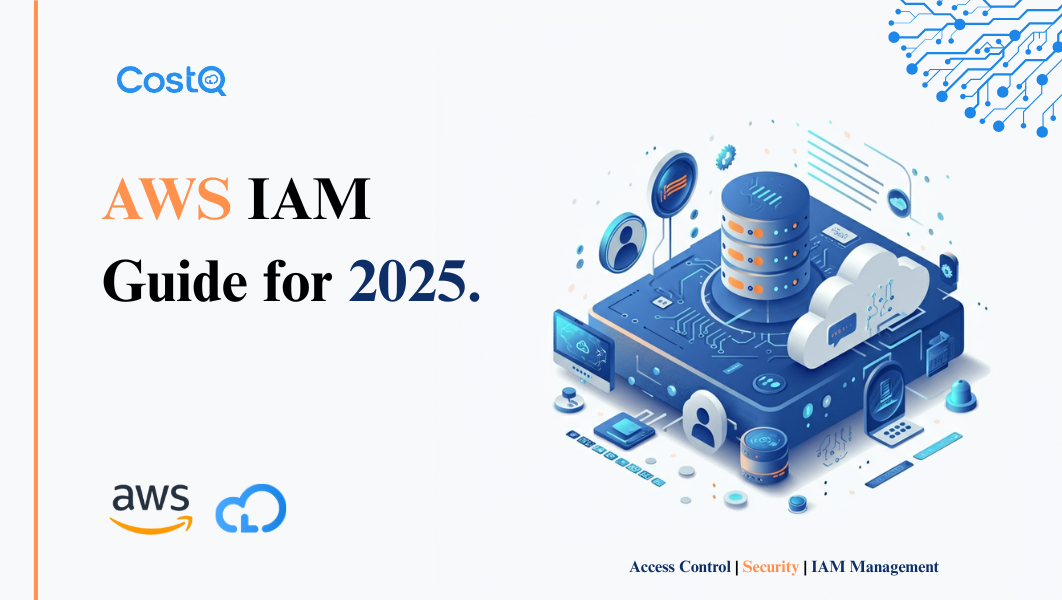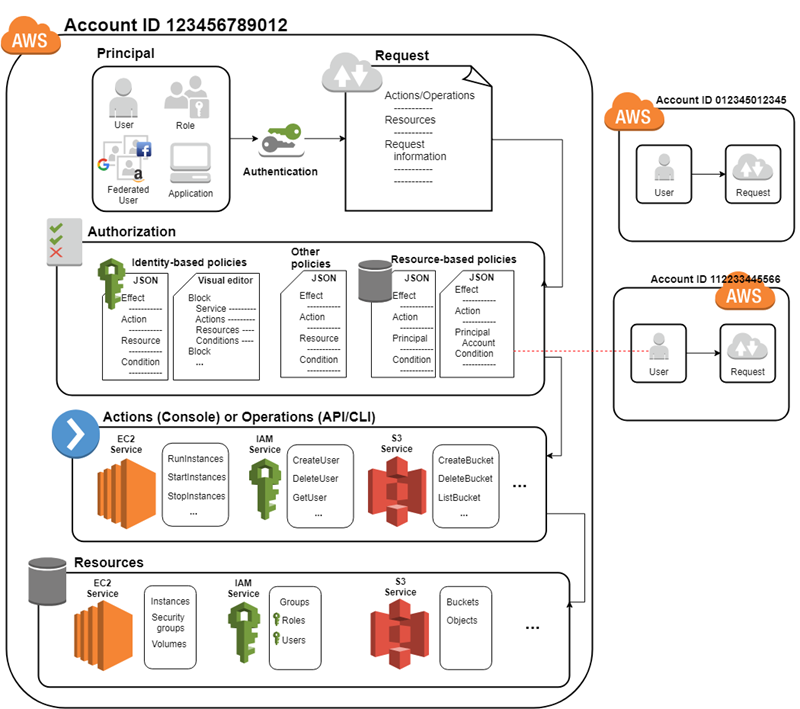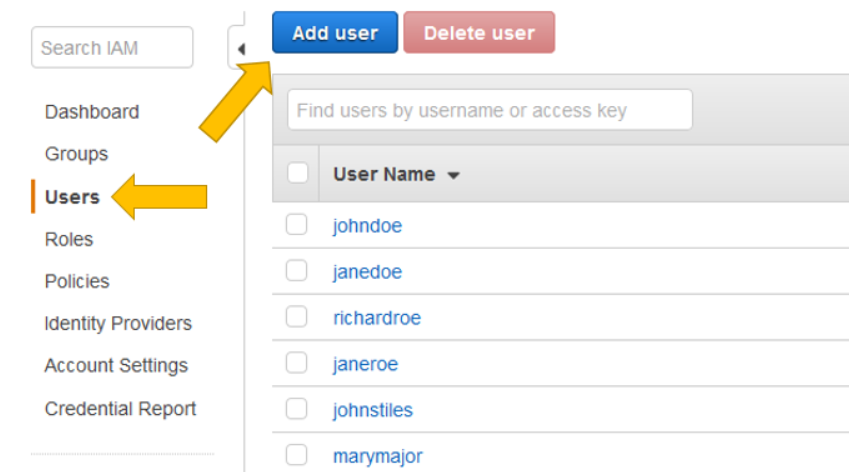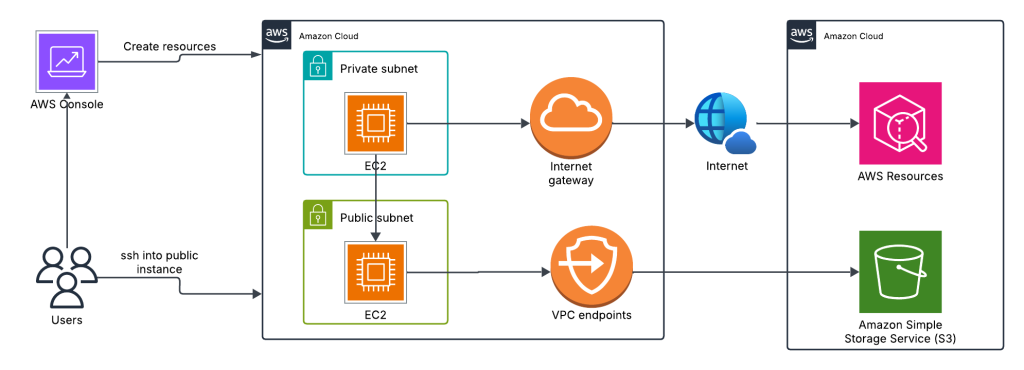Nabin Adhikari
The Ultimate AWS IAM Guide for 2025: Critical Concepts You Must Know

Contents
In a cloud-first world, securing your AWS environment meticulously goes beyond firewalls and encryption — it also encompasses everything surrounding access — who accesses what, when, and by which means. Cloud security is, fundamentally, about access control. It guarantees that the accurate systems and individuals interact with your resources, and only through validated procedures. Migrating more workloads to AWS leads to increased management complexities for permissions and identities, resulting in robust access control mechanisms becoming critical.
Amazon Web Services (AWS) Identity and Access Management (IAM) is the crux of security in AWS. AWS IAM provides various features including setting up policies which enable you to control, manage, and monitor actions users and groups take within your AWS ecosystem. Implementation of the principle of least privilege, automating access control, and merging with identity management solutions from enterprises are all made possible by IAM. No matter if you are a seasoned cloud engineer or just stepping into the AWS world, learning IAM is the one stop solution for maintaining secure and compliant cloud systems and infrastructures.
In this guide, you’ll learn:
- The main components and concepts of IAM.
- The steps taken in IAM’s operations.
- Special features such as identity federation and permissions boundaries.
- Real-life scenarios and possible mistakes.
- Best practices for IAM in 2025.
- Frequently reviewed questions and recommended professional advice.
After finishing this guide, you will be able to securely define, implement and control access in AWS, safeguarding your workloads while letting your teams work quickly and safely.
What is AWS IAM?
AWS Identity And Access Management (IAM) is a worldwide AWS service that allows the secure administration of AWS resource access. You can manage users, groups and roles as well as permissions that define access levels to specific actions such as EC2, S3, RDS etc.
Why protect AWS resources?
Your cloud infrastructure is built on AWS resources like EC2 instances, S3 buckets and RDS databases. Most of them contain confidential information or host important applications. Improper protection measures can lead to data breaches, outages, or significant monetary losses.
Global scope:
IAM is not bound to a region. Its settings cover your entire AWS account assuring uniform access management to your resources regardless of their location.

Core Components of IAM:
Users:
Definition:
An IAM user is a single person or application that has been granted direct access to AWS. Every user must possess individual credentials (passwords and/or access keys).
Example:
Set up a user ‘John’ with permissions to view S3 resources. Now John will be able to log into the console and have CLI view enabled, but will only be able to view the S3 resources.

Groups:
What are Groups?
They are a set of IAM users. Granting certain permission to a group means all the users under that group automatically get the same predetermined access level.
Why Use Them?
Groups help ease management burdens. For example, a Builders group may have EC2 management permissions. When the permission is granted (or removed) to the group with no additional configuration, the users will automatically have the access without needing to change group settings.
Example:
View S3Bucket is true for the ‘Developers’ group, hence, they are able to start and stop EC2 instances but are not able to delete S3 buckets.
Roles:
Role vs User vs Group:
As has been noted earlier, a role is an identity assigned by AWS along with certain restrictions defined permissions. A role is not linked to any one user permanently. Assigning roles is temporary, which can be done by users, some AWS services, or external identities.
S3 bucket can now be accessed from an EC2 instance without any credentials being hardcoded. The instance takes on a role which AWS takes care of giving critical credentials.

Policies:
Policies Policies are documents like these written in json syntax:
Policies form permissions boundaries which include which actions are permitted or denied, what resources can be acted on, and the conditions under which these can be done.
Managed and Inline Policies.
Managed Policies: These policies can exist on their own, meaning they can be detached or attached to several users, groups, or roles.
Inline Policies: Policies that do grant specific singular permissions within a user, group, or role pouch.
Example:
The below is a JSON policy which gives total control of S3.
{
"Version": "2012-10-17",
"Statement": [
{
"Effect": "Allow",
"Action": "s3:*",
"Resource": "*"
}
]
}
Advanced IAM Features.
Identity Federation: Enables users from other identity systems (such as Corporate Directories or Social Logins) to access AWS without creating IAM users. AWS Security Token Service(STS) issues temporary credentials post successful authentication, which mitigates the risk associated with long lived credentials.
IAM Identity Center (AWS SSO):
Enhances and manages access across various AWS accounts and applications from a single point. Connects with identity repositories such as Microsoft Active Directory or SAML 2.0, allowing Single Sign On (SSO) based access for users to all assigned resources.
Permissions Boundaries:
Establish the upper limit of permissions a user or role can have, for example under certain custom policies that are provided in addition to other policies, narrower permissions will be set. Helps in granting a large degree of delegation of scope of permissions management safely in large companies.
Service Linked Roles:
Roles which are tied directly to AWS services so that the services can execute actions using the customer’s identity in a secure manner.
How AWS IAM functions?
IAM maintains security by implementing policies detailing the actions and resources a user or application can manipulate, along with conditions under which these actions can occur.
Policies based on identity:
Bound to users, groups or roles, which specify what resources could be manipulated and what actions can be taken with the input.
Policies based on resources:
Directly bound to resources themselves (Such as S3 buckets policies), allowing definement of who could have access alongside the manner of access.
Authentication:
Checks the identity of a user or application (using password, access keys or federated login).
Authorization:
Verifies the policies provided to see if the action in question is within the limits. Unless allowed by a policy, all actions will, by default, be denied. Policies that deny actions will always take precedence in case of explicit denial.
IAM Best Practices.
- Use the principle of least privilege: Users should be given just the right amount and type of permissions needed for carrying out duties: no more, no less.
- Enable Multi-Factor Authentication (MFA): Require MFA from all users, and especially from privileged or root accounts, for enhanced account security.
- Regularly rotate credentials: Passwords and access keys should be changed periodically to reduce risk in case of credential compromise.
- Use IAM roles for applications and services: AWS credentials should never be embedded within application code. Instead, roles should be assigned to EC2, Lambda, or ECS tasks for secure and temporary access.
- Avoid using the root user for everyday tasks: The root account should be preserved for critical account level actions only.
- Log IAM events with AWS CloudTrail: Evaluate and keep a record of all AWS IAM activity, track suspicious behavior, and ensure compliance for audit purposes.
- Automate audits and reviews: Make use of AWS IAM Access Analyzer, credential reports, and AWS Config for regular auditing at the account level to evaluate access and permissions and ensure compliance.
- “Implement strong password policies” will mean: Implement temperature controls on the password complexity and rotation settings on user accounts.
- “Centralize identity management” means: Use directory service federation and IAM Identity Center to unify access control for multiple accounts.
Real-world AWS IAM Examples.
1. Granting a user read-only S3 access
Step-by-step:
-
Go to IAM > Users > Add user in AWS Console.
-
Enter username (“John”), select “Programmatic access” and/or “AWS Management Console access.”
-
Attach the “AmazonS3ReadOnlyAccess” managed policy.
-
Review and create the user.
JSON policy example:
{
"Version": "2012-10-17",
"Statement": [
{
"Effect": "Allow",
"Action": [
"s3:Get*",
"s3:List*"
],
"Resource": "*"
}
]
}
2. EC2 instance accessing S3 using a Role
Steps:
-
Create an IAM role with the “AmazonS3ReadOnlyAccess” policy.
-
Specify “EC2” as the trusted entity.
-
Launch or modify your EC2 instance and attach the role.
Policy JSON snippet:
Use the managed policy “AmazonS3ReadOnlyAccess” or the custom policy above.
3. Developers group with limited EC2 access
-
Developers can describe, run, stop, start, and terminate EC2 instances, but not manage AMIs or security groups.
Example policy:
{
"Version": "2012-10-17",
"Statement": [
{
"Effect": "Allow",
"Action": [
"ec2:DescribeInstances",
"ec2:RunInstances",
"ec2:StopInstances",
"ec2:StartInstances",
"ec2:TerminateInstances"
],
"Resource": "*"
}
]
}4. Home and shared directories in S3 for users and groups
-
Each user has a home directory in an S3 bucket; developers and managers have shared directories.
Example directory structure:
/amzn-s3-demo-bucket
/home
/zhang
/major
/share
/developers
/managers
Policy for Zhang Wei:
{
"Version": "2012-10-17",
"Statement": [
{
"Effect": "Allow",
"Action": ["s3:GetObject", "s3:PutObject", "s3:ListBucket"],
"Resource": [
"arn:aws:s3:::amzn-s3-demo-bucket/home/zhang/*",
"arn:aws:s3:::amzn-s3-demo-bucket/home/zhang/"
]
}
]
}5. Policy for developers to access DynamoDB but deny table deletion
JSON policy snippet:
{
"Version": "2012-10-17",
"Statement": [
{
"Effect": "Allow",
"Action": [
"dynamodb:PutItem",
"dynamodb:GetItem",
"dynamodb:UpdateItem"
],
"Resource": "*"
},
{
"Effect": "Deny",
"Action": "dynamodb:DeleteTable",
"Resource": "*"
}
]IAM Monitoring and Auditing
- Security and compliance rely on the proper monitoring and auditing of IAM actions.
- AWS CloudTrail: CloudTrail captures all API calls relating to AWS IAM for auditing and incident response, so use it to flag suspicious or unauthorized activities.
- IAM Access Analyzer : IAM Access Analyzer scans the policies of AWS resources for unintended cross-account or public access, so set automatic notifications for policy changes or potentially risky activity.
- Credential Reports: Use credential reports to check the status of IAM users and their credentials to manage unused accounts or credentials that could pose a security risk.
- Best Practices: Use CloudTrail, employ Alerts and IAM review tools actively, enable CloudTrail, regularly check on IAM permissions, run an Access Analyzer , and configure Alerts for any suspicious activity.
Advanced IAM Techniques
- Permisions Boundaries: Set maximum permissions for roles and users within the limits of IAM to eliminate the challenge of overprovisioning.
- IAM Access Advisor: IAM Access Advisor shows service utilization within each role and allows better permission management.
- Service-linked Roles: Use least privilage permits to give AWS services authority to act in your name.
- Automatic Audit Tools: For seamless and tight monitoring, AWS Config, Access Analyzer, and other applicable third party tools can be used for continuous compliance.
Deficient IAM Functionality and Solutions
- Deficient vision: Employ Inventory List and the Access Analyzer to monitor permission distribution throughout the different accounts.
- Substandard provisioning and deprovisioning: Prevent the proliferation of orphaned accounts with automation over user life cycle management. The same goes for over privileged accounts.
- Zombie Accounts: Periodically audit and eliminate identities that have not been used.
- Shifting roles: Make it a point to change group membership promptly when there is a change in the job position of the user.
- Masked privilege escalation: Setup policies to use permission boundaries and least privilege access for masking privilege elevation.
Troubleshooting IAM Issues
- Permission related mistakes: Examine inter-user and inter-role policies and employ the AWS IAM Policy Simulator to troubleshoot.
- Policies that are incorrect: Go over attached policies to remove the overly general permissions and make sure all attached policies are broad in nature.
- Role trust relationship mistakes: Check if trust cross account or service access policies are complementary in a correctly set manner.
- Management of access keys: Regularly rotate unused keys together with leaked keys.
- Integration of EKS with Kubernetes: Merge IAM roles and Kubernetes RBAC for enhanced security and cluster accessibility.
Frequently Asked Questions (FAQs)
Q: What exactly is AWS IAM?
A: AWS IAM is a service that enables managing access to AWS services and resources securely by setting up users and groups and controlling permissions assigned to them through roles and policies.
Q: How does AWS IAM work?
A: AWS IAM controls everything within Amazon Web Services, including authorization, authentication, and what the user is allowed to do on their account. Access is not given unless a statement with a policy permits it. A statement can either be assigned or attached to a user account, a group, a role, or a resource.
Q: What is the principal of least privilege?
A: Only issue the minimum needed to accomplish a task without “excess” privileges that increase risk if a credential is exposed.
Q: What are the differences between IAM users and roles?
A: Users are set to applications or people and have permanent credentials, while roles are applied to services and users temporarily and have short term credentials allowing for better security.
Q: What types of IAM policies exist?
A: Identity, permission boundary, service control, resource, session policies. Most frequently used policies are identity and resource policies.
Q: In what order are a deny and allow statements processed and which one wins?
A: An explicit “Deny” is enforced unconditionally and wins.
Q: How do you keep track of what is done in IAM?
A: To audit and monitor access, use AWS CloudTrail, IAM Access Analyzer, and credential reports.
Q: How can I manage AWS IAM in a proactive fashion?
A: Implement automation with AWS CloudFormation, Terraform, or AWS Config which serves as infrastructure and enforces policy.
Q: What is identity federation?
A: It enables users from other identity providers to sign in to AWS using links and temporary credentials instead of requiring distinct IAM users.
Q: How do I troubleshoot IAM permission errors?
A: Checking block and allow policies, the IAM Policy Simulator, reviewing logs on CloudTrail, and checking trust polices would help.
Conclusion
The management of resources is IAM, which is the core strength regarding accessing security, defining who can what actions on your resources, enforcing those mechanisms, and auditing after the policies might have been acted upon. Leveraging AWS IAM concepts, advanced features, and best practices creates secure, compliant, and scalable cloud environments. Routinely audit your setup, automate wherever possible, enforce least privilege, and don’t forget about IAM in the AWS Free Tier and in the documents offered by AWS.
Also remember that cloud security is just one area of optimizing the full scale of AWS offerings. If you’re interested in gaining better visibility into AWS cost monitoring, usage tracking, spending control, and security, see our detailed guide on how CostQ provides simplification and ease in AWS cost management. It’s the next move needed after optimizing IAM policies.
Follow the link to learn more: AWS Cost Optimization with CostQ.
Nabin Adhikari
Cloud Expert
Expert in cloud infrastructure and cost optimization with over a decade of experience in helping companies reduce their cloud spending while maintaining performance.